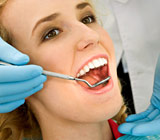Seven Things You Should Know About Oral Cancer
 Let’s talk about oral cancer. Yes, it’s a scary subject — but the truth is, the more you know about it, the better able you are to protect yourself.
Let’s talk about oral cancer. Yes, it’s a scary subject — but the truth is, the more you know about it, the better able you are to protect yourself.
- Who is more likely to get oral cancer? Because of your genetic disposition — heredity — men are twice as likely to develop oral cancer as women. African-Americans have a higher incidence than Caucasians. The disease is also related to aging, although in recent years many young people have been diagnosed with this disease.
- Are some habits related to development of oral cancer? Risk factors include use of tobacco in any form, both smoking and chewing, chronic exposure to sun, and consumption of alcohol. Moderate to heavy drinkers have a three to nine times greater risk than non-drinkers. Tobacco smokers are at five to nine times greater risk than non-users, and users of snuff or chewing tobacco are at four times greater risk than non-users.
- Where do most oral cancers occur? The most common areas are in the mouth itself, the lips, the tongue, and the pharynx (back of the mouth and throat).
- What are the statistics for survival after treatment for oral cancer? Conquering cancer depends most on early detection. Since most cases of oral cancer are discovered at a late stage, survival is poor, with less than 60% surviving five years after treatment. When oral cancers are detected early, the survival rate is more than 80%.
- What are some of the symptoms of oral cancer? Most oral cancers are “squamous” (small scale-shaped) cell carcinomas in the lining of the mouth. Signs of these cancers can be seen as white or red patches in the early pre-cancerous stage. These develop into an ulcer that does not heal.
- When should you seek medical help? If you notice color changes (white or red patches) or sores or ulcers anywhere in your mouth that do not heal within two or three weeks, go to your dentist for a checkup right away. Sometimes the sores resemble cold sores. A definitive diagnosis requires a tissue biopsy, in which a small piece of tissue is removed under anesthesia and taken to a lab for microscopic examination.
- What about regular routine examinations? An oral cancer examination should be part of your visit to our office. We will inspect your face, neck, lips and mouth for signs of cancer, feel the floor of the mouth and sides of the neck for any lumps, examine your tongue and the back of your throat. The American Cancer Society recommends a cancer related check-up annually for all individuals aged 40 and older and every three years for those between 20 and 29.
Contact Dr. Cindy Sumarauw at 801-281-3500 to schedule an appointment to discuss your questions about oral cancer. You can also learn more by reading the Dear Doctor magazine article “Oral Cancer.”


Leave a Reply